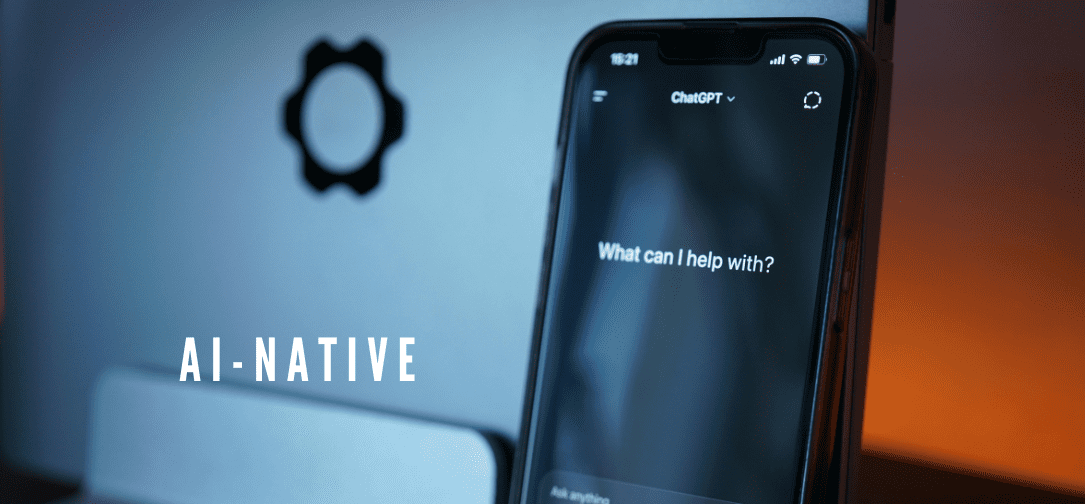Most businesses either use or want to use AI. But most aren’t doing it properly.
The problem is that many businesses are adopting AI in the wrong way. They bolt AI widgets onto legacy systems, layering tool after tool, hoping it all adds up to transformation. It doesn’t.
As a result, organizations are left with a patchwork of half-integrated tools, workflows riddled with gaps, and security blind spots that multiply with every new add-on. MIT research found that 95% of generative AI projects fail to deliver meaningful outcomes, often because of poor integrations and messy bolt-ons.
So, how can organizations get the most out of AI? By becoming ‘AI-native’.
What Does AI-Native Mean?
AI-native businesses build technologies in a way that assumes AI will be part of every process from day one. That means:
- Systems are connected by design. Data flows through clean, secure APIs so tools talk to each other without endless custom fixes.
- The stack is modular. You can swap in new models or databases as technology improves, without tearing everything apart.
- AI is part of the workflow. Everything happens automatically inside the systems people already use, without manual steps or extra tools.
Precious few organizations are actually AI-native. According to McKinsey, 78% of organizations now use AI in at least one business function, but research from MLQ.ai suggests that only 5% of enterprises have AI tools integrated in workflows at scale.
Clearly, the gap between using AI and being AI-native is huge.
The Problem with Bolt-Ons
It makes sense that organizations would want to bolt on AI tools. They’re quick to deploy, typically have low upfront costs, and are easy to test. But problems arise fast.
Different tools use different data formats. Systems don’t talk to each other properly. Teams end up juggling multiple platforms that overlap in some areas and leave gaps in others. That overlap drives wasted spend, and the gaps create security risks.
A recent report found that delays in AI rollout – a consequence of bolting on AI tools – is costing UK businesses up to 5% of monthly revenue. Even worse, nearly one-third of employees admit to secretly using AI at work, creating serious compliance and security headaches.
Why AI-Native Businesses Work Better
Building an AI-native stack creates a solid foundation that allows AI to actually accelerate your business,not slow it down. AI-native organizations:
- Move faster: New ideas don’t stall in IT because integrations are built in. Pilots can scale without months of rework.
- Adapt more easily: When a better model or tool comes along, it slots in without rebuilding everything around it.
- Stay more secure: Access controls, audit trails, and reporting are part of the foundation, not an afterthought. That keeps governance intact even as AI use grows.
- Scale with confidence: Instead of cobbling together one-off projects, AI is built into the workflow itself, meaning it scales consistently across teams.
Put simply, bolt-ons add complexity; native design delivers lasting improvements.
The Agentic AI Advantage
But building natively offers another huge advantage: unlocking agentic AI.
AI agents are autonomous systems that can set goals, make decisions, and carry out tasks end-to-end. They can qualify leads, triage security alerts, or coordinate workflows across departments, offering enormous efficiency benefits and freeing up humans for more valuable work.
However, to do this safely and effectively, they need an infrastructure that’s been designed differently from the start. That means:
- Clean APIs so agents can pull the right data at the right time.
- Modular systems so you can plug in the best models for each job and swap them as technology improves.
- Secure handoff points and oversight so agents can act without creating risk.
With this foundation, you can fully customize how agents work, decide which tasks to automate, and ensure humans stay in control of high-stakes decisions. Without it, agents are just another shiny tool that won’t scale and can introduce new risk.
Built by Humans, for Humans
But let’s not get ahead of ourselves. AI-native doesn’t mean AI replacing human staff. It means creating systems that are built by humans, for humans. Systems designed to make people more effective, not redundant.
Your employees are already experimenting with AI to speed up their work, and often without approval. That tells you two things: the demand is there, and the risk is growing. By turning your organization AI-native, you take scattered, underground experimentation and turn it into a secure, transparent, and scalable way of working.
And because the stack is designed for AI from the start, you can proactively build in the things that usually get left until last: compliance, reporting, and transparency. This way, guardrails are more than just an afterthought.
Being AI-Native is the Next Obvious Step
Becoming AI-native should be a priority for businesses that want to remain competitive.
AI-native stacks offer the speed, flexibility, compliance, and ability to scale agentic AI safely. It makes your employees more efficient and takes repetitive manual work off their plate. And, best of all, it turns AI from a collection of scattered tools into a growth engine you can control.
Businesses that become AI-native will surge ahead of their competitors. Those that don’t, won’t. The only real question left is whether you make the move now, or be forced to play catchup later.
About the Author: Josh Breaker-Rolfe is a Content writer at Bora. He graduated with a degree in Journalism in 2021 and has a background in cybersecurity PR. He’s written on a wide range of topics, from AI to Zero Trust, and is particularly interested in the impacts of cybersecurity on the wider economy.



































